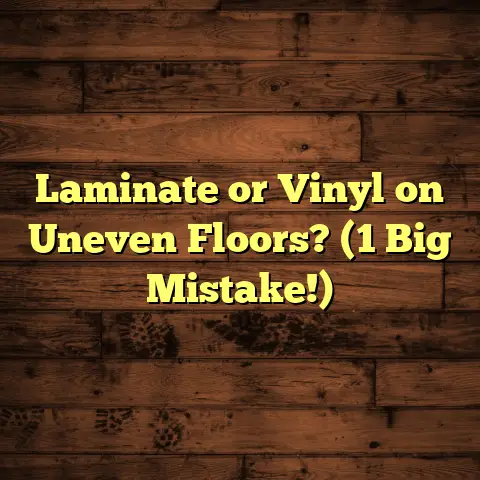Make Tile Floor Grippy! (2 Anti-Slip Tips!)
Did you know that nearly 1 million Americans visit the emergency room each year due to slip and fall accidents? Many of these happen on slippery tile floors. It’s a scary thought, right? Let’s dive into how we can make our homes and workplaces safer, one tile at a time.
1. Understanding the Importance of Anti-Slip Flooring
Alright, let’s get real. Slip resistance isn’t just a nice-to-have; it’s a need-to-have. Whether it’s your home, a bustling restaurant, or a quiet hospital, nobody wants a nasty fall.
So, what makes tile floors slippery in the first place? Well, it’s a mix of things. The type of tile plays a big role. Polished porcelain, for example, can be like an ice rink when wet. The finish matters too. A glossy finish looks great, but it’s often less grippy than a matte one. And let’s not forget the obvious: water, spills, and even just humidity can turn your beautiful tiles into a hazard zone.
2. Exploring the Risks Associated with Slippery Floors
Let’s talk numbers. The National Safety Council says falls are a leading cause of injury-related deaths in the US. It’s not just about a bruised ego; we’re talking serious injuries like fractures, head trauma, and even worse.
And it’s not just the physical toll. Think about the financial burden. Medical bills, lost work time, and even potential lawsuits can add up fast. I’ve seen businesses almost go under because of a single slip and fall incident.
I remember one case in particular. A local bakery had a beautiful, but highly polished, tile floor. After a rainy day, a customer slipped and broke their wrist. The bakery ended up paying a hefty settlement, and they had to close for a week to install anti-slip treatments. It was a wake-up call for everyone in the community.
3. Tip 1: Apply Anti-Slip Coatings
Okay, let’s get practical. Anti-slip coatings are like magic potions for your floors. They work by adding texture to the tile surface, increasing the friction and giving you better grip.
What are Anti-Slip Coatings?
Think of them as a clear layer you apply on top of your existing tile. They’re designed to create a surface that’s easier to grip, even when wet.
Types of Anti-Slip Coatings
There are two main types: water-based and solvent-based.
-
Water-Based Coatings: These are eco-friendly, low-odor, and easy to clean up. They’re great for residential use and areas with good ventilation.
-
Solvent-Based Coatings: These are tougher and more durable, making them ideal for high-traffic areas like restaurants and commercial kitchens. However, they have a stronger odor and require more careful handling.
I’ve personally used both types. For my own kitchen, I went with a water-based coating. It was easy to apply, and I didn’t have to worry about harsh fumes. But for a client’s busy restaurant, I recommended a solvent-based coating for its superior durability.
Step-by-Step Guide to Applying Anti-Slip Coatings
Alright, let’s get our hands dirty! Here’s a step-by-step guide to applying anti-slip coatings:
-
Preparation is Key: Clean the tile floor thoroughly. Remove any dirt, grease, or wax. I recommend using a degreaser and a good scrub brush. Rinse well and let the floor dry completely.
-
Etch the Surface (If Required): Some coatings require etching the tile surface to create better adhesion. Follow the manufacturer’s instructions carefully. This usually involves applying an etching solution, letting it sit for a few minutes, and then rinsing thoroughly.
-
Apply the Coating: Use a roller or brush to apply a thin, even layer of the anti-slip coating. Work in small sections to ensure even coverage.
-
Drying Time: Let the coating dry completely according to the manufacturer’s instructions. This can take anywhere from a few hours to a full day. Avoid walking on the floor during this time.
-
Apply a Second Coat (Optional): For added protection, consider applying a second coat. This is especially useful in high-traffic areas.
Safety Precautions
-
Ventilation is Crucial: Make sure the area is well- ventilated, especially when using solvent-based coatings.
-
Wear Protective Gear: Wear gloves and eye protection to avoid skin and eye irritation.
-
Read the Instructions: Always follow the manufacturer’s instructions carefully.
Maintenance Tips
-
Regular Cleaning: Clean the floor regularly with a mild detergent and water. Avoid using harsh chemicals or abrasive cleaners.
-
Re-Apply as Needed: Anti-slip coatings will wear down over time, especially in high-traffic areas. Re-apply the coating every 1-2 years, or as needed.
4. Tip 2: Use Non-Slip Mats and Rugs
Okay, let’s talk about another easy and effective way to make your tile floors grippy: non-slip mats and rugs. These are especially great for high-risk areas like kitchens, bathrooms, and entryways.
Choosing the Right Non-Slip Mats
-
Material Matters: Look for mats made of rubber, PVC, or other materials with good grip.
-
Thickness Counts: Thicker mats provide more cushioning and stability.
-
Design Considerations: Choose mats that match your décor and fit the space properly. Avoid mats that are too large or too small, as they can become tripping hazards.
I always recommend rubber-backed mats for bathrooms. They’re water-resistant and provide excellent grip, even when the floor is wet. For kitchens, I prefer mats with a textured surface to help prevent slips from spills.
Proper Placement and Maintenance
-
Placement is Key: Place mats in areas where slips are most likely to occur, such as in front of sinks, stoves, and doorways.
-
Secure the Edges: Make sure the edges of the mats are flush with the floor to prevent tripping hazards. You can use rug tape or adhesive to secure the mats in place.
-
Regular Cleaning: Clean the mats regularly to remove dirt and debris. Follow the manufacturer’s instructions for cleaning.
-
Replace Worn Mats: Replace mats when they start to show signs of wear, such as frayed edges or loss of grip.
5. Comparative Analysis: Coatings vs. Mats
So, which is better: anti-slip coatings or non-slip mats? Well, it depends on your specific needs and circumstances.
Anti-Slip Coatings: Pros and Cons
-
Pros:
- Long-lasting protection
- Seamless appearance
- Easy to clean
-
Cons:
-
Requires more effort to apply
- May require etching
- Can be more expensive upfront
Non-Slip Mats: Pros and Cons
-
Pros:
- Easy to install
- Affordable
- Can be moved and re-positioned
-
Cons:
-
May not cover the entire floor
- Can be a tripping hazard if not properly placed
- Requires regular cleaning
I’ve found that coatings are generally better for larger areas or areas where you want a seamless look. Mats are great for smaller areas or areas where you need temporary protection.
For example, in a commercial kitchen, I’d recommend using anti-slip coatings on the entire floor for maximum protection. But in a home bathroom, a non- slip mat in front of the shower might be all you need.
6. Enhancing Overall Safety Beyond Anti-Slip Solutions
Okay, so we’ve covered anti-slip coatings and non-slip mats. But there’s more we can do to make our spaces safer.
-
Proper Lighting: Make sure your floors are well-lit to avoid tripping hazards.
-
Regular Cleaning: Keep your floors clean and dry to prevent slips.
-
Appropriate Footwear: Encourage family members or employees to wear shoes with good traction.
-
Education is Key: Educate everyone about the importance of safety and how to prevent slips and falls.
I always tell my clients that safety is a team effort. It’s not just about the flooring; it’s about creating a culture of safety in your home or workplace.
7. Conclusion
So, there you have it! Making your tile floors grippy is essential for preventing accidents and creating a safer environment. Whether you choose to apply anti-slip coatings, invest in non-slip mats, or both, the key is to take action.
Don’t wait until someone gets hurt. Start today and make your floors safer for everyone. And if you’re not sure where to start, don’t hesitate to consult with a flooring professional. We’re here to help!
Remember, a grippy floor is a happy floor!





